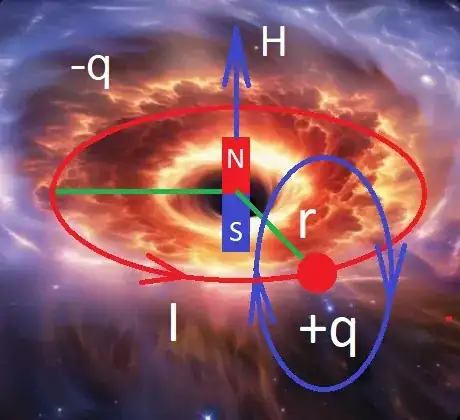I imagine the magnetic field comes from the accretion disk. But what causes it to "spring" upward?
3 Answers
How do the black holes create their magnetic fields? I can imagine that accretion disk, it has a movement of rotation, since it can be observed. The light comes from the emission of electrons, that could be lost, because of the heating. The matter would be accelerated around the central star, and spontaneously emits that light. It's like in a LASER device, where an active medium receives energy and emits light. Due to these spontaneously transitions, the matter looses electrons and becomes degenerated.
So the accretion disk would have more heavy particles, like protons and neutrons. When this disk is rotating at a very high speed, it will generate an electric current. This current is consisting of many positive particles, which are moving around. The heavy particles without an electric charge, can have their own magnetic moments of spin. As a result, the rotating electric stream generates a very strong magnetic field. It could be of understanding, that are also produced some relativistic field effects. This could be an explanation for the magnetic field being generated around the star.
Here's a more intuitive image of this description:
Edited:
There are more stars types, which do emit jets of plasma and radiation, and in fact, they are actually natural lasers, but instead of emitting visible light, they're loosing electric charged particles and strong radiation, like X, or Gamma.
That high magnetic field, on a closed field line around the moving charges, when it is rotating, it produces an electric displacement, that can be associated with a separation of the electric charges, so that it works like a trap for them.
All the known electromagnetic laws could be valid only to individual particles. It is a principle of individual actions, which also could be applied here, as a superposition of the effects. Like for instance, it may be that Ampere law of the magnetic circuit, expressed locally, in a differential form:
$$\mu_0 \cdot (\nabla \times \vec{H}) =\mu_0 \cdot {\vec{J}}$$
Integrating over a closed surface, can result the size of an electric current. This is a circular electric current, because this $\vec{J}$ is a current density.
$$\mu_0 \iint_S \vec{J} d\vec{S} = \mu_0 {I}$$
But I has the meaning of an electric charge displacement in a time interval, which can be just the period for a complete rotation. And this time, can be also expressed in function of the moving speed $\vec{v}$
$$I = \frac{d}{d t} (q)$$ $$dt = \frac{r}{v} \cdot d\alpha$$
Where $\alpha$ is the angular rotation. And the electric charge can be separated as a constant for the punctual charge. Nobody says, the radius of rotation r, and the speed v, are constant.
Only for an elementary variation in a differential equation, these can be constant. In a hypothesis, that on the horizon of the events, where the speed is closing to the light speed, the relative time is expanding, and most of the elementary variations, can be minimized to $0$.
The radius, could be expressed as a relativistic contraction with the speed.
$$r = r_0 \sqrt{1 - (\frac{v}{c})^2}$$
However, the spatial terms, or the radial component of the rotation, can be eliminated using the Stokes' Theorem.
$$\mu_0 \iint_S (\nabla \times \vec{H}) \cdot d\vec{S} = \mu_0 \int_l \vec{H} d\vec{l}$$
Where:
$${d\vec{l} = \vec{r} \cdot d\alpha} \;\vert\vert\;_{0 \ \le \ \alpha \ \le \ {2 \Pi}}$$
In a more general relativistic movement, should be studied the Lorentz forces. So, the effects could be more complex, than simply generating a magnetic field. It could be find some more valuable references visiting the next address:
- 15
There are solutions to the Einstein-Maxwell equations with magnetic fields, such as those of the Ernst class of solutions. In that, the field extent to asymptotic regions, does lacking an astronomical interpretation for them, in such regions. However as quoted, black holes with accretion disks have huge magnetic fields around them, and the influence of these fields in the event horizon curvature supersedes the matter itself, does being a major contribution to the geometry. In that sense, the Ernst class of solutions can be a good candidate for the geometry. E. g. that with mass and magnetic field,
\begin{equation} ds^2 = \Lambda^2\Big( -(1-2m/r)dt^2 + (1-2m/r)^{-1}dr^2 + r^2 d\theta^2 \Big) + \Lambda^{-2} r^2\sin^2 \theta d\phi^2 \end{equation}
with $\Lambda = 1 + B^2r^2 \sin^2 \theta$, $B$ the magnetic field.
- 672
I imagine the magnetic field comes from the accretion disk.
Yes, Although there are theoretical black hole models without accretion disks, most (maybe all ?) physical black holes have accretion disks, and the material in the accretion disk that is close to the event horizon will be hot enough to become a plasma. And the moving charges within the plasma generate a magnetic field.
Analysing the behaviour of the magnetic field in a plasma is not simple, and gives rise to a whole field of physics called magnetohydrodynamics. In fact, in this case you would need relativistic magnetohydrodynamics.
- 63,999
